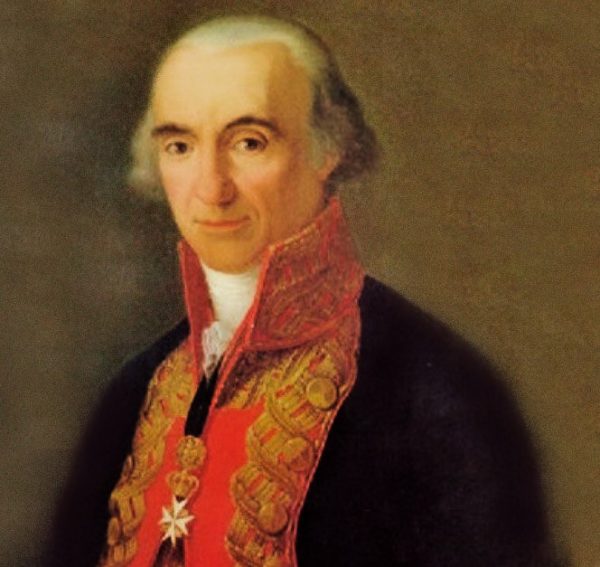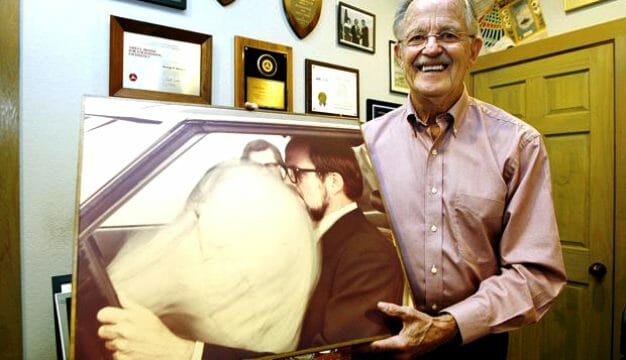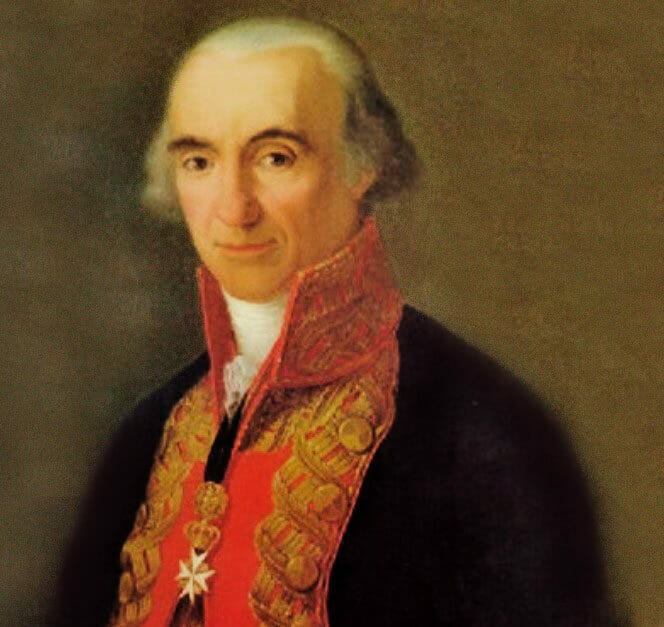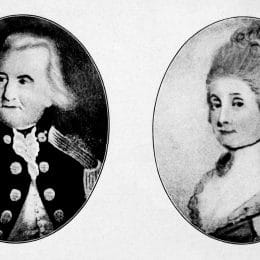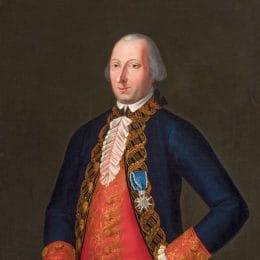de Ezpeleta y Galdeano, José Manuel
José Manuel de Ezpeleta y Galdeano (1742-1823) was a Spanish soldier who would possess many titles over his lifetime, notably first governor of the Mobile District of Spanish West Florida from 1780 to 1781. He was an important lieutenant of Bernardo de Gálvez, perhaps the most significant Spanish military and political leader in the region during Alabama's colonial era. Ezpeleta commanded troops on many campaigns, including the 1780 Battle of Fort Charlotte in Mobile as part of the effort to drive British forces from the region. More broadly, Ezpeleta lived and fought during a critical period when the major European powers of Britain, France, and Spain sought to control what is now the southeastern United States, shaping the future states of Alabama, Florida, Georgia, Louisiana, and Mississippi.
José Manuel de Ezpeleta y Galdeano was born in Barcelona, Spain, on January 24, 1742, to Joaquín de Ezpeleta y Dicastillo, a native of Pamplona, and María Engracia Galdeano y Prado of Olite. His father's family had roots in the present-day commune of Espelette in southwestern France just north of the border with Spain. Because his older brother was to inherit the lordship of Beire, he grew up knowing he would join the military, following in the footsteps of his family stretching back generations. Ezpeleta joined the military at age 14 and quickly climbed through the ranks. In 1763, he was placed in charge of an elite unit and sent to Havana, Cuba, to help ease the new governor's transition and professionalize the troops stationed there. Ezpeleta then returned to Spain, where he taught in military academies, before returning to Havana with a battalion of troops in 1779. That year, Spain declared war on Great Britain as an ally of France, which was an ally of the Americans, launching the Anglo-Spanish War (1779-1783). In an effort to keep the British from expanding throughout the Caribbean and the Gulf of Mexico, Col. Ezpeleta and his elite regiment were sent to drive the British out of West Florida and to reconquer any territory that the English had occupied, including Mobile.
Initially founded as a small French fort and parish in 1702 by Pierre Le Moyne d'Iberville and his younger brother, Jean-Baptiste Le Moyne de Bienville, Mobile became the capital of what was then the French colony of Louisiana until 1720. Its position on the Mobile River and the Gulf of Mexico made the emerging city strategically important; the French would construct Fort Condé (later Fort Charlotte under the British) there in 1723. Following the British victory in the French and Indian War in 1763, the French surrendered control of Mobile to the British. Bernardo de Gálvez, governor of Louisiana and Cuba and Viceroy of New Spain, along with Ezpeleta, then captured Fort Charlotte during the 1780 Battle of Fort Charlotte. The fort was renamed Fuerta Carlota. The Spanish victory secured the Mobile District for Spain. It was bounded on the north by the 31st Parallel North, on the south by Gulf of Mexico, on the east by Perdido River, and on the west by Pearl River. This territory was added to Spanish West Florida, opening the way for Spanish operations against Pensacola in 1781. Ezpeleta was promoted to major general of the Army of Operation, and became governor of the district, serving from 1780 until 1781. In that capacity, he decreed that any former British subjects who would not declare loyalty to the Spanish monarch could leave, but most did and remained.
Ezpeleta garrisoned some 190 Spanish soldiers at a palisade known as La Aldea (The Village or Village of Mobile) that the Spanish had constructed on the eastern shore of Mobile Bay at the site of present-day Spanish Fort. In January 1781, the soldiers successfully defended themselves against a group of 500 British colonists, soldiers, German mercenaries, and Creek soldiers who were loyal to the British. The battle is considered the bloodiest day in Alabama during the American Revolution. After Ezpeleta ensured that the Spanish were safely in control of Mobile, he joined Bernardo de Gálvez for the successful Siege of Pensacola, the capitol of British West Florida. That victory evicted the British from the region, and the two men would then move against British interests in the Caribbean. Following the American Revolution, Ezpeleta served as interim governor of Louisiana and West Florida prior to the appointment of Esteban Rodriguez Miró y Sabater.
Ezpeleta proved to be a loyal soldier and close friend to de Gálvez and would serve as his chief of staff for some time. As a result, de Galvez frequently left Ezpeleta in charge of his initiatives in Cuba, Spanish West Florida, and New Spain (later the Louisiana Purchase) whenever he returned to Spain. Meanwhile, Mobile would become the center for trade relations between Spain and the region's Native American tribes.
While stationed in present-day Cap-Haitien (Guárico), Haiti, Ezpeleta married Maria de la Paz Enrile y Alcedo, an Italian from a distinguished family, in 1781. The couple had ten children, and all six of his sons followed in their father's footsteps and joined the Spanish military. Later, Ezpeleta was involved in negotiations between Spain and Creek leader Alexander McGillivray's (Hoboi-Hili-Miko) who desired Spanish arms to prevent American intrusion on Creek land, corresponding with the Spanish charges d’affaires in Philadelphia, Diego de Gardoqui. He also approved conferences in Mobile and Pensacola led by Esteban Rodriguez Miró y Sabater and other Spanish officials that resulted in the 1784 Treaty of Pensacola, a defensive alliance between Spain and the Creeks. The treaty also led Spain to grant a trade monopoly to U.S. merchants Panton, Leslie, and Company instead of a Spanish firm, appeasing McGillivray who wanted a steady supply of trade goods. Soon after, similar treaties were also signed at Mobile between Spain and the Alabamas, Chickasaws, and Choctaws.
Between 1785 and 1789, Ezpeleta served as captain-general and governor of Cuba and restructured the government on the island. He improved the defensive infrastructure and also launched a series of public works projects, including the construction of elaborate government buildings, the publication of a newspaper, and promotion of the arts. He would later serve in South America as Viceroy of New Granada and achieve the ranks of brigadier and field marshal, in 1792. In December 1796, he returned to Spain, where he would hold various political and military offices, including promotion to lieutenant general and being granted the title of Count of Ezpeleta de Beire in recognition of his accomplishments.
When French emperor Napoleon Bonaparte started what became known as the Napoleonic Wars in his effort to expand French territory in Europe, Ezpeleta fought the French invasion of Spain and refused to swear allegiance to Joseph Bonaparte, who had recently been installed as the King of Spain. He was sent to Montpellier, France, and held as a political prisoner for five years, but was treated well because of his rank and station. He was released in 1814 and then held several other political offices in Spain until his death on November 23, 1823, though sources differ whether in Madrid or Pamplona.
Further Reading
- Beerman, Eric. "José de Ezpeleta: Alabama's First Spanish Commandant During the American Revolution." Alabama Review 54 (October 1976): 249-260.
- Holmes, Jack. "Alabama's Bloodiest Day of the American Revolution: Counterattack at the Village, January 7, 1781." Alabama Review 53 (July 1976): 208-219.
- Holmes, Jack. "Alabama's Forgotten Settlers: Notes on the Spanish Mobile District: 1780-1813." Alabama Historical Quarterly 33 (Summer 1971): 87-97.
